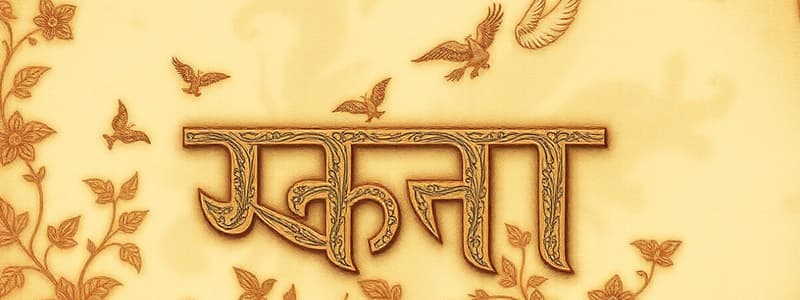Podcast
Questions and Answers
What is the primary script used to write Hindi?
What is the primary script used to write Hindi?
- Roman script
- Arabic script
- Devanagari script (correct)
- Cyrillic script
Which sentence structure does Hindi primarily follow?
Which sentence structure does Hindi primarily follow?
- Verb-Subject-Object (VSO)
- Object-Subject-Verb (OSV)
- Subject-Object-Verb (SOV) (correct)
- Subject-Verb-Object (SVO)
How is Hindi vocabulary primarily influenced?
How is Hindi vocabulary primarily influenced?
- Exclusively by English
- Only by regional languages
- Only by Sanskrit
- By several languages including Sanskrit, Persian, and Arabic (correct)
Which of the following is NOT a major dialect of Hindi?
Which of the following is NOT a major dialect of Hindi?
Which of the following elements is included in Hindi phonetics?
Which of the following elements is included in Hindi phonetics?
What role does Hindi play in Bollywood films?
What role does Hindi play in Bollywood films?
What is one of the current trends regarding Hindi usage?
What is one of the current trends regarding Hindi usage?
What does the Hindi language primarily convey regarding cultural significance?
What does the Hindi language primarily convey regarding cultural significance?
Flashcards are hidden until you start studying
Study Notes
Overview of Hindi
- Hindi is an Indo-Aryan language primarily spoken in India.
- It is one of the 22 scheduled languages of India and is the official language of the Indian government.
- Hindi is part of the larger Hindustani language group, which includes Urdu.
Script and Phonetics
- Hindi is written in the Devanagari script, which consists of 46 primary characters, including vowels and consonants.
- The script is syllabic, where each character represents a syllable.
- Hindi phonetics includes a range of sounds, including voiced and voiceless consonants, aspirated sounds, and nasalized vowels.
Dialects
- Major dialects of Hindi include:
- Khari Boli (standard Hindi)
- Awadhi
- Bhojpuri
- Magahi
- Maithili
- Variations exist in pronunciation, vocabulary, and grammar across these dialects.
Grammar
- Hindi follows a Subject-Object-Verb (SOV) sentence structure.
- Nouns have gender (masculine and feminine) and number (singular and plural).
- Verbs are conjugated based on tense, aspect, mood, and subject agreement.
Vocabulary
- Hindi vocabulary is influenced by Sanskrit, Persian, Arabic, Portuguese, and English.
- Sanskrit contributes significantly to formal and literary Hindi.
- Everyday spoken Hindi often incorporates words from English and regional languages.
Cultural Significance
- Hindi is a medium for a rich literary tradition, including poetry, novels, and plays.
- Bollywood films, primarily in Hindi, have popularized the language globally.
- Hindi is a key language for communication in Northern and Central India.
Language Learning
- Hindi is increasingly taught as a second language worldwide, with resources available for learners.
- Basic conversational skills include greetings, common phrases, and understanding cultural contexts.
Current Trends
- The use of Hindi on digital platforms is growing, with a significant presence on social media.
- Efforts are underway to standardize and promote Hindi in education and administration.
Conclusion
- Hindi is a vital language with a deep cultural heritage and a significant role in contemporary society in India and beyond.
Overview of Hindi
- Hindi is an Indo-Aryan language predominantly spoken in India.
- Recognized as one of India’s 22 scheduled languages, it serves as the official language of the Indian government.
- Hindi belongs to the Hindustani language group, which includes Urdu.
Script and Phonetics
- The Devanagari script is used to write Hindi, comprising 46 key characters (vowels and consonants).
- Devanagari is syllabic; each character corresponds to a syllable rather than an individual sound.
- Hindi phonetics features diverse sounds, including both voiced and voiceless consonants, aspirated phonemes, and nasalized vowels.
Dialects
- Significant Hindi dialects include:
- Khari Boli (considered standard Hindi)
- Awadhi
- Bhojpuri
- Magahi
- Maithili
- Dialects exhibit differences in pronunciation, vocabulary, and grammatical structures.
Grammar
- Hindi employs a Subject-Object-Verb (SOV) syntax.
- Nouns are gendered (masculine and feminine) and change form based on number (singular and plural).
- Verb conjugation is influenced by tense, aspect, mood, and agreement with the subject.
Vocabulary
- Hindi vocabulary draws heavily from languages such as Sanskrit, Persian, Arabic, Portuguese, and English.
- Sanskrit is a major source, especially for formal and literary expressions.
- Conversational Hindi commonly incorporates English terms and words from regional dialects.
Cultural Significance
- Hindi supports a rich literary heritage, encompassing poetry, novels, and theatrical works.
- Bollywood films, mainly produced in Hindi, enhance the language's global recognition and popularity.
- Hindi is crucial for communication in the northern and central regions of India.
Language Learning
- The global interest in learning Hindi is rising, with various educational resources available.
- Essential skills for beginners include basic greetings, common phrases, and an understanding of cultural nuances.
Current Trends
- The use of Hindi is expanding on digital platforms, particularly on social media.
- Initiatives are being implemented to standardize and promote Hindi in educational systems and administrative sectors.
Conclusion
- Hindi is not just a language but a significant cultural entity with a profound heritage, playing an essential role in modern society both in India and internationally.
Studying That Suits You
Use AI to generate personalized quizzes and flashcards to suit your learning preferences.




